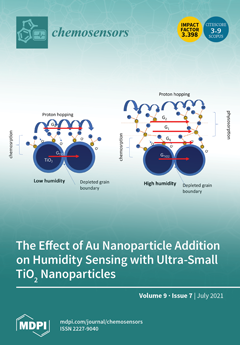A comparative study is presented on the photoluminescence (PL) response toward molecular oxygen (O
2) in tin dioxide (SnO
2), zinc oxide (ZnO) and titanium dioxide (TiO
2) nanoparticles. The findings show that both PL enhancement and PL quenching can
[...] Read more.
A comparative study is presented on the photoluminescence (PL) response toward molecular oxygen (O
2) in tin dioxide (SnO
2), zinc oxide (ZnO) and titanium dioxide (TiO
2) nanoparticles. The findings show that both PL enhancement and PL quenching can be observed on different materials, arguably depending on the spatial localization of the defects responsible for the PL emission in each different oxide. No significant results are evidenced for SnO
2 nanoparticles. ZnO with red/orange emission shown an O
2-induced PL enhancement, suggesting that the radiative emission involves holes trapped in surface vacancy oxygen centers. While the ZnO results are scientifically interesting, its performances are inferior to the ones shown by TiO
2, which exhibits the most interesting response in terms of sensitivity and versatility of the response. In particular, O
2 concentrations in the range of few percent and in the range of a few tenths of a part per million are both detectable through the same mixed-phase TiO
2 sample, whose rutile phase gives a reversible and fast response to larger (0.4–2%) O
2 concentration while its anatase phase is usable for detection in the 25–75 ppm range. The data for rutile TiO
2 suggest that its surfaces host deeply trapped electrons at large densities, allowing good sensitivities and, more notably, a relatively unsaturated response at large concentrations. Future work is expected to improve the understanding and modeling of the photophysical framework that lies behind the observations.
Full article





